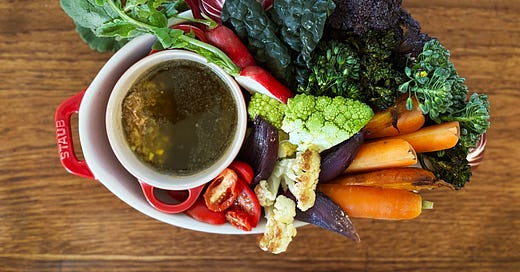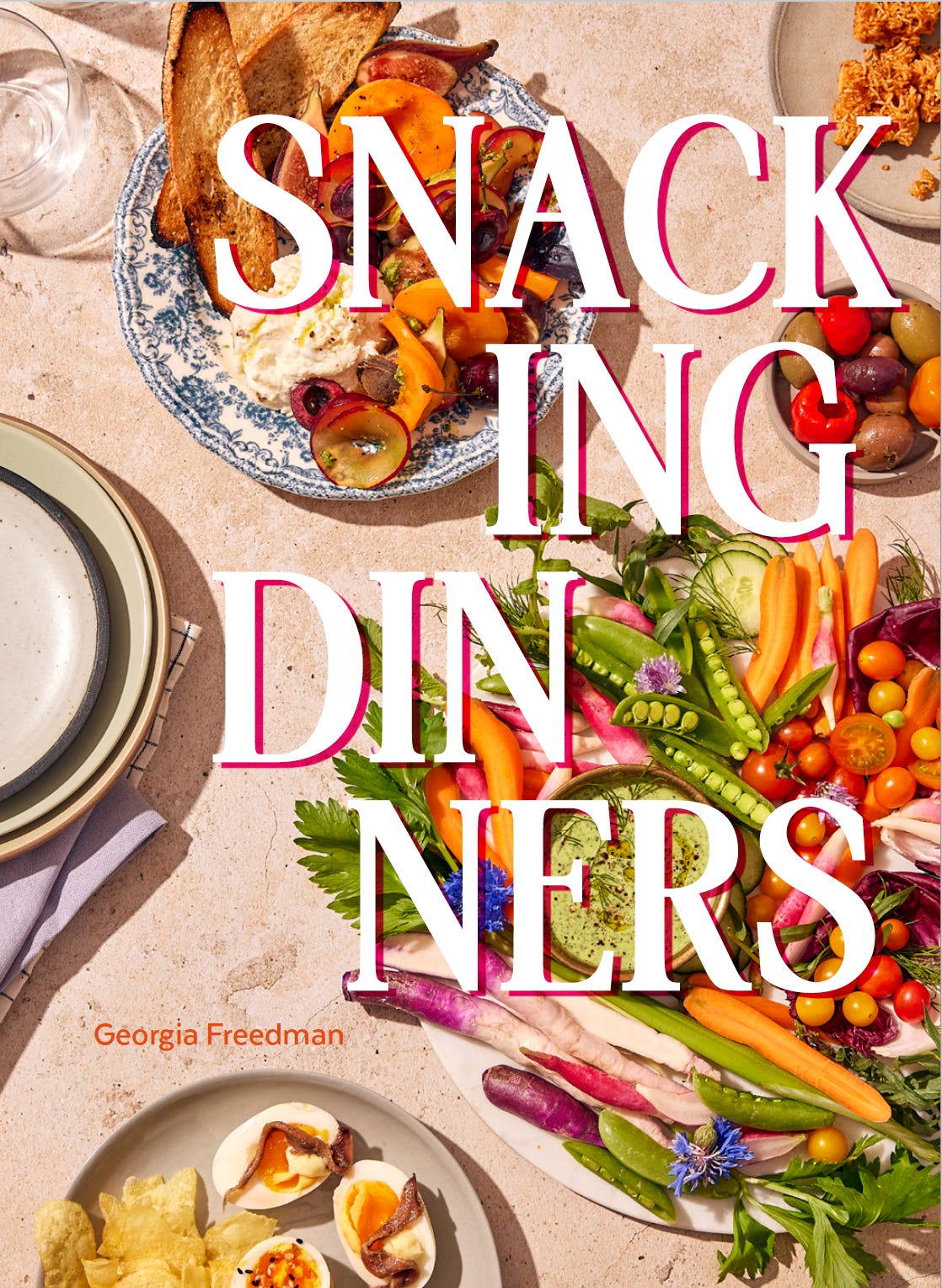Wintery Crudités with Bagna Càuda
It's hard to go wrong with garlic, anchovies, and olive oil.
Did you make a New Years Resolution to cook more? To eat more vegetables? Or maybe to give yourself a break and try to make life a little easier? This recipe can help with all of those goals, because eating healthy is a lot easier if you have easy, delicious ways to do it.
Bagna càuda—a warm olive oil dip filled with garlic and anchovy—might sound funny if you’ve never had it, but the flavor is amazing, kind of like if Caesar salad was reborn as a warm dip. It’s a classic way to start a meal in Italy’s mountainous Piedmont region, and it’s extremely simple to throw together: All you have to do, really, is put everything in a pot for a couple minutes and stir.
For more quick-and-easy (and delicious!) meals, pre-order a copy of my upcoming book SNACKING DINNERS! As a bonus, I’ll happily send you a free signed bookplate and enter you up for fun prize drawings. (Pre-orders are a huge boost for sales rankings and encourage indie bookstores to stock the book.)
(Quick Note: This newsletter is still in its infancy—if you like it, please share with a friend or hit the “like” button below to help me build my audience!)
While you can eat bagna càuda any time of year, I particularly like it in winter, when the warm dip (which translates to “hot bath”) can turn a plate of vegetables into something cozy and comforting. I also really like it with wintery vegetables, like brassicas, because their strong flavors stand up well to the pungent garlic and anchovy.
While this dish is traditionally served with raw vegetables (with a few notable exceptions, like cardoons), I like to roast some of mine, if I have time before dinner (or if I can plan ahead and roast them the day before). For the meal shown in these photos, I roasted half of my carrots, cauliflower, Romanesco, broccolini, and cherry tomatoes and kept half raw—then added some fresh radishes, kale, and Treviso radicchio. (I also roasted red onion; I wouldn’t recommend adding that one raw, however.)
Once your vegetables are prepped (roasted or not) all you have to do is cook the bagna càuda; you can even bring the pot straight to the table, if you like. You can dip your vegetables gingerly or use them to scoop up big bites of anchovy for lots of omega-3s and monounsaturated fatty acids. It’s like eating a big salad with your fingers but also feels warming on a cold night.
If you have sauce left over after your vegetables are done, you can sop it up with some nice crusty bread or save it for another use. In Piedmont, cooks often use the extra oil to cook eggs. I like to refrigerate the leftovers, along with some extra roast vegetables, and use it all to make a delicious grain bowl later in the week when I have time to cook some farro or wild rice.
Wintery Crudités with Bagna Càuda
Fresh and/or roasted winter vegetables such as carrots, broccolini, kale, Treviso radicchio, and cauliflower/Romanesco
⅓ cup extra virgin olive oil, plus more if roasting vegetables
Kosher salt and freshly ground pepper (if roasting vegetables)
1 tablespoon unsalted butter
5 garlic cloves, minced
One 50-ounce tin anchovy filets (about 12 filets), drained
Crusty whole-grain bread (optional)
For the Fresh Vegetables:
Trim the vegetables into easy-to-eat pieces by removing the tough parts of stems, cutting carrots and radishes in half or quarters (lengthwise), removing the tough inner ribs of kale leaves, breaking up cauliflower into florets, etc.
If Roasting Some of the Vegetables:
Preheat the oven to 425°F.
Cut carrots lengthwise in halves or quarters, trim the ends off of broccolini and scallions, an onion and cut it into wedges, making sure each wedge has part of the root base, so it will stay together.
For nice big pieces of cauliflower or Romanesco, cut them lengthwise through the center, to expose the thick central stem, then cut a couple ½-inch slices from that central part of the head, keeping the stem intact so that the florets around it stay attached (each slice should look like a tree, with a trunk running up the center and slices of floret extending out like leafy branches; if you like, you can also cut each “tree” in half lengthwise).
Working with one type of vegetable at a time, toss them in olive oil, season them well with salt and pepper, and lay them on a sheet tray, keeping like with like (so it’s easier to see when each is done).
Roast the vegetables until they are brown on the side touching the pan, then flip them and continue roasting until the whole thing is relatively tender, flipping more as needed. The vegetables will cook at different rates, so be prepared to remove each type as it finishes—tongs and a second, cold sheet tray are useful here.
To Make the Bagna Càuda:
Put the ⅓ cup olive oil and the butter in a small pot and heat them over medium until the butter has melted and is foaming a bit.
Turn the heat to low. Add the garlic and give it a stir, then add the anchovies.
Cook the mixture, breaking up the anchovy filets with a wooden spoon until they are in very small pieces, 2–3 minutes.
Serve warm to dip the vegetables into and use the bread to sop up the extra, if you like.
What are your favorite ways to add vegetables to the plate? Any favorite snacking meals? I’d love to hear about them!
Photos: Georgia Freedman







What a gorgeous presentation, almost like a cornucopia of vegetable delights! Mixing roasted and raw is a great idea. I think my 7 year old would love this, it's a must try! Would it be all wrong to use the anchovies that come in a tube like tomato paste?